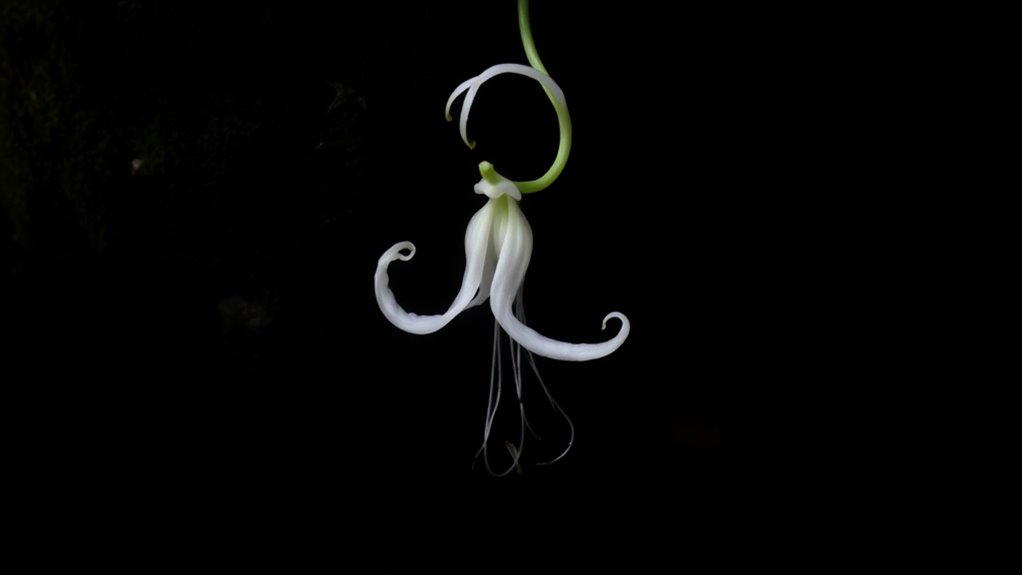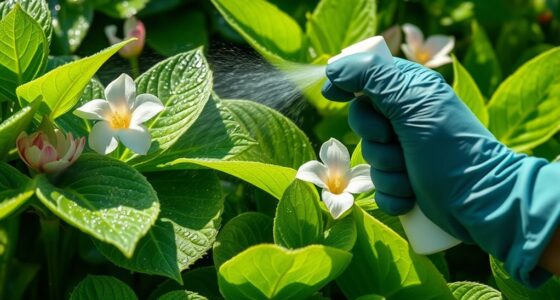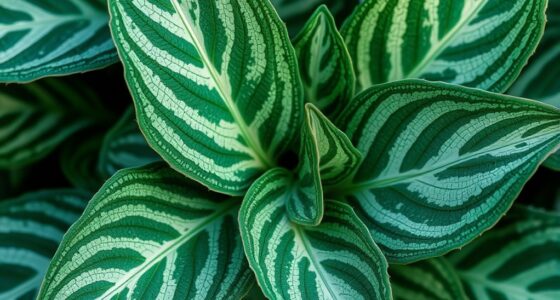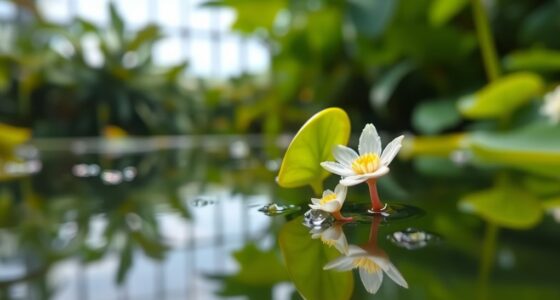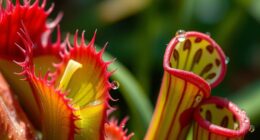The ghost orchid survives without leaves or photosynthesis by forming a special partnership with fungi in its environment. It’s a mycoheterotroph, relying on these fungi to obtain nutrients by connecting to nearby tree roots. This symbiotic relationship allows it to thrive in specific wetlands and swamps, making it deeply dependent on its ecosystem. Curious about how this delicate balance keeps the orchid alive? Keep exploring to uncover more fascinating details.
Key Takeaways
- The ghost orchid survives without leaves by relying on a symbiotic relationship with mycorrhizal fungi in its environment.
- It is a mycoheterotroph, obtaining nutrients directly from fungi connected to nearby tree roots.
- Its leafless, translucent flowers are energy-intensive, with no need for photosynthesis.
- Its unpredictably timed blooms help reduce disturbance and over-harvesting.
- The orchid’s survival depends on a delicate ecological balance with fungi and specific habitat conditions.
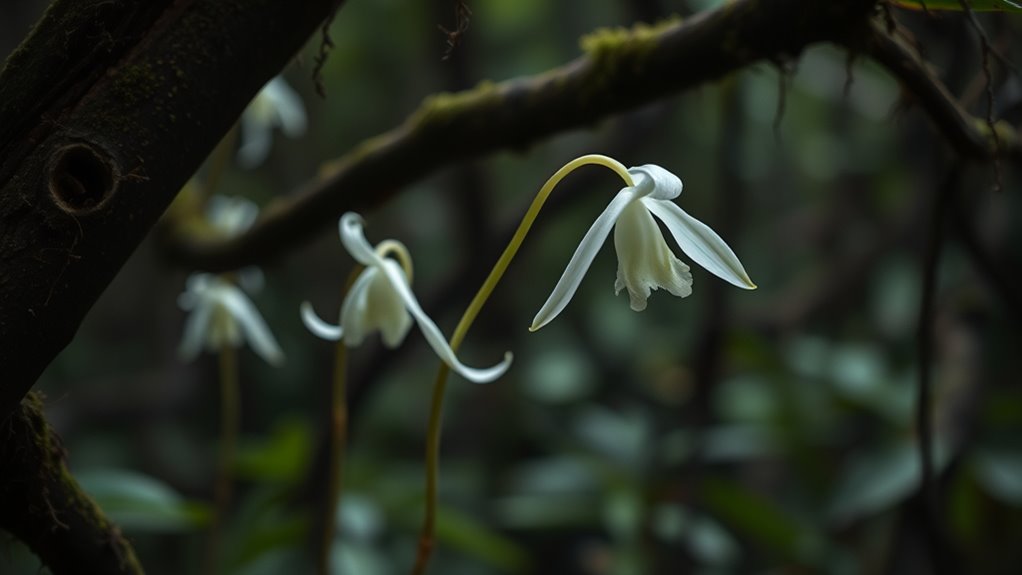
Have you ever heard of the ghost orchid, a rare and elusive bloom that seems to vanish before your eyes? If you’ve ever tried to spot one in the wild, you know it’s like searching for a whisper in the wind. This stunning, ethereal flower appears and disappears with such grace that it feels almost supernatural. But how does the ghost orchid survive without any leaves? That’s the mystery that has fascinated botanists and nature lovers alike. Unlike most plants, it doesn’t rely on broad green leaves to photosynthesize and produce energy. Instead, it has developed a unique survival strategy rooted in its relationship with fungi and other plants.
The ghost orchid’s secret lies in its parasitic nature. It’s a mycoheterotroph, meaning it depends on a symbiotic relationship with mycorrhizal fungi that inhabit the roots of nearby trees. These fungi connect to the roots of the surrounding trees and act as intermediaries, transferring nutrients from the host trees to the orchid. This process allows the ghost orchid to obtain the necessary nutrients and energy without ever making its own food through photosynthesis. Because it doesn’t need leaves to capture sunlight, the orchid can dedicate its energy to producing its striking, translucent flowers that seem to float in the air. Its reliance on symbiotic relationships with fungi and the surrounding ecosystem explains why the ghost orchid is so elusive. It’s not just a matter of hiding; it’s a delicate balance of relationships that must be just right for the plant to thrive. The orchid is highly selective about the fungi it partners with, which is why it’s often found in specific habitats—like the wetlands and hardwood swamps of Florida and parts of Cuba. These environments provide the perfect conditions for its fungal partners to flourish. Its fleeting appearance is also an adaptive trait—by blooming unpredictably, it reduces the chances of being over-harvested or disturbed by humans, ensuring its survival in the wild.
Frequently Asked Questions
How Long Can a Ghost Orchid Survive Without Flowering?
You can expect a ghost orchid to survive several months without flowering, especially if conditions stay favorable. During this time, it relies on its underground rhizomes and root system to store energy and sustain itself. If you provide proper moisture and avoid disturbance, the orchid can remain healthy and dormant, waiting for the right environmental cues to bloom again. Patience and proper care are key to its survival during these periods.
Does the Ghost Orchid Produce Any Scent?
The ghost orchid produces a subtle, enchanting scent that’s barely noticeable—like a whisper in the wind. You might miss it if you’re not paying close attention, but it’s there. Its fragrance isn’t overpowering; instead, it draws pollinators quietly and effectively. This delicate scent helps the orchid survive in its mysterious way, blending into its environment and ensuring its survival without the need for bold fragrances.
Are Ghost Orchids Ever Cultivated Outside Their Natural Habitat?
Yes, you can cultivate ghost orchids outside their natural habitat, but it’s quite challenging. They require specific conditions like high humidity, indirect light, and a suitable mycorrhizal fungus to thrive. If you’re attempting to grow one, you’ll need patience and precise care, mimicking their native environment as closely as possible. While rare, successful cultivation outside their natural habitat is possible with dedication and proper setup.
What Pollinates the Ghost Orchid?
Did you know that ghost orchids rely on a specific insect for pollination? You’ll find that giant sphinx moths, attracted by the flower’s scent, are their primary pollinators. When these moths visit, they inadvertently transfer pollen between flowers, ensuring the orchid’s reproduction. If you’re exploring Florida’s swamps, watch for these nocturnal moths, as their visits are vital for the ghost orchid’s survival and incredible bloom.
Can Ghost Orchids Adapt to Changing Climate Conditions?
Yes, ghost orchids can adapt to changing climate conditions, but their success depends on specific environmental factors. You can help by preserving their natural habitats, reducing pollution, and supporting conservation efforts. As temperatures rise and weather patterns shift, these orchids may struggle, so staying aware of their needs and promoting climate resilience becomes essential. Your actions can make a difference in ensuring their survival amid climate changes.
Conclusion
You’ve seen how the ghost orchid’s silent, leafless existence defies expectations, thriving in the shadows. Like a whisper in the wind, it reminds you that sometimes, survival means going unnoticed, blending into the background. Its mysterious dance of life teaches you that appearances can be deceiving—sometimes, the most fragile things hold the strongest secrets. Keep an eye out; nature’s true magic often hides in plain sight, waiting for you to discover its silent strength.

